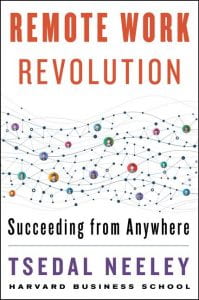 The Covid pandemic caused a worldwide migration to remote work. Suddenly, digital tools became the primary enablers for daily interactions. Remote work has benefits: costs and travel budgets get slashed, and lower gas emissions improve environmental sustainability. Remote work also has challenges: people feel isolated, out of sync, and out of sight, questions emerge about bonding, trusting and alignment, and videoconferences lead to tech exhaustion. A portion of the workforce will now permanently maintain some remote days in their routine long-term. Virtual, distributed, and global work will expand our repertoire, skills, and performance, and make us and our organisations better.
The Covid pandemic caused a worldwide migration to remote work. Suddenly, digital tools became the primary enablers for daily interactions. Remote work has benefits: costs and travel budgets get slashed, and lower gas emissions improve environmental sustainability. Remote work also has challenges: people feel isolated, out of sync, and out of sight, questions emerge about bonding, trusting and alignment, and videoconferences lead to tech exhaustion. A portion of the workforce will now permanently maintain some remote days in their routine long-term. Virtual, distributed, and global work will expand our repertoire, skills, and performance, and make us and our organisations better.
Trust
Teams that have previously established norms for communication or other ways of working together are well primed for remote work. Psychological safety is the key to productive teamwork. Leaders must actively foster an atmosphere that makes everyone feel safe speaking up and asking questions. When leaders share themselves; open up and share autobiographical insights, it helps to cultivate emotional trust.
Productivity
The reality is that most managers have limited power over employee productivity, even when co-located. Remote work increases productivity. The hallmark of remote work is the ability to self-direct and capitalise on the gift of managing your own work processes. Flexibility of scheduling is particularly invaluable for remote workers who have to negotiate the demands of work and family at the same time. The answer to professional isolation is developing cognitive and emotional connection with one another. When those connections are strong, the team is cohesive. When the team is cohesive, it is productive. A cohesive remote team has the capacity to be even more productive than its bricks-and-mortar counterpart. Lean into the inherent flexibility. Encourage autonomy.
Digital Tools
In 2011, Thierry Breton, CEO of global information technology giant Atos, announced that he would ban email. The onslaught of email in people’s inboxes was causing them to work extra hours to respond. “We are producing data on a massive scale that is fast polluting our working environments and also encroaching into our personal lives.” Internal emails are now replaced with social networks, instant messaging systems, and collaborative tools. It is the leader’s job to decide the desired communication culture and then choose the tools to achieve that for a remote workforce. Tech exhaustion happens when we treat work communication activities in the virtual world in the same way that we do in the physical world, yet don’t add the constraints that we do in the latter. Using a mix of available media – synchronous and asynchronous – to match our goals lessens tech exhaustion.
Remote Teams
Prepare for virtual meetings asynchronously by brainstorming in group documents prior to the meeting enabling spontaneous collaboration. Coming to a decision is often much easier than hashing everything out in a co-located office. Deliberately orchestrate daily or frequent meetings and give each person a dedicated time to speak without interruption before handing the virtual baton to the next person.
Leading Virtually
Virtual leadership requires frequent communication with team members. Hearing from the boss helps make the present and future more predictable. Such predictability gives shape to daily work. Remote workers crave predictability.